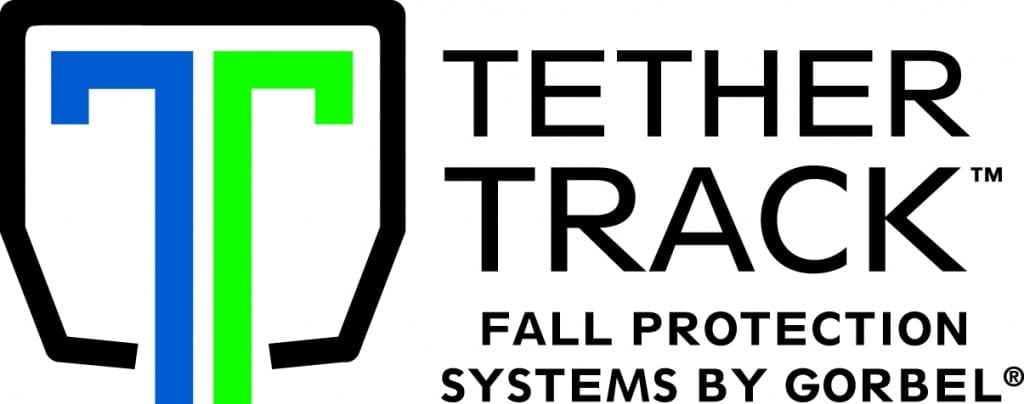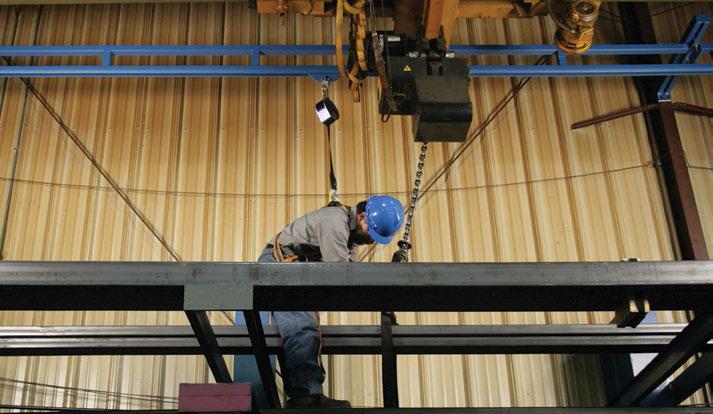Your Employees’ Safety Hangs in the Balance
The facts are alarming. According to 2009 data compiled from the Bureau of Labor Statistics, 605 workers were killed, and an estimated 212,760 were seriously injured by falls to the same or lower level.
Fall injuries constitute a considerable financial burden, as well. For example, Workers’ Compensation and medical costs associated with occupational fall incidents have been estimated at approximately $70 billion annually in the United States.
1 Falls are among the most common causes of serious work-related injuries and deaths.
2 Worker safety is imperative, and developing and implementing a fall protection program not only prevents injuries, but could save lives as well. In addition, regulatory agencies have increased fines for noncompliance with fall protection standards.
While there are a number of reasons why many companies are not meeting today’s requirements for fall protection, the fact remains that employers have a legal and moral obligation to protect their people.
OSHA Fall Protection 101
Complying with today’s workplace health and safety requirements is easier said than done. Which rules and standards apply to you? What’s recommended and what’s required?
Before you can even start to develop a Fall Protection Plan you need to determine your company’s legal obligations. A good starting point is to visit the Fall Protection section of the OSHA website: www.osha.gov/SLTC/fallprotection.
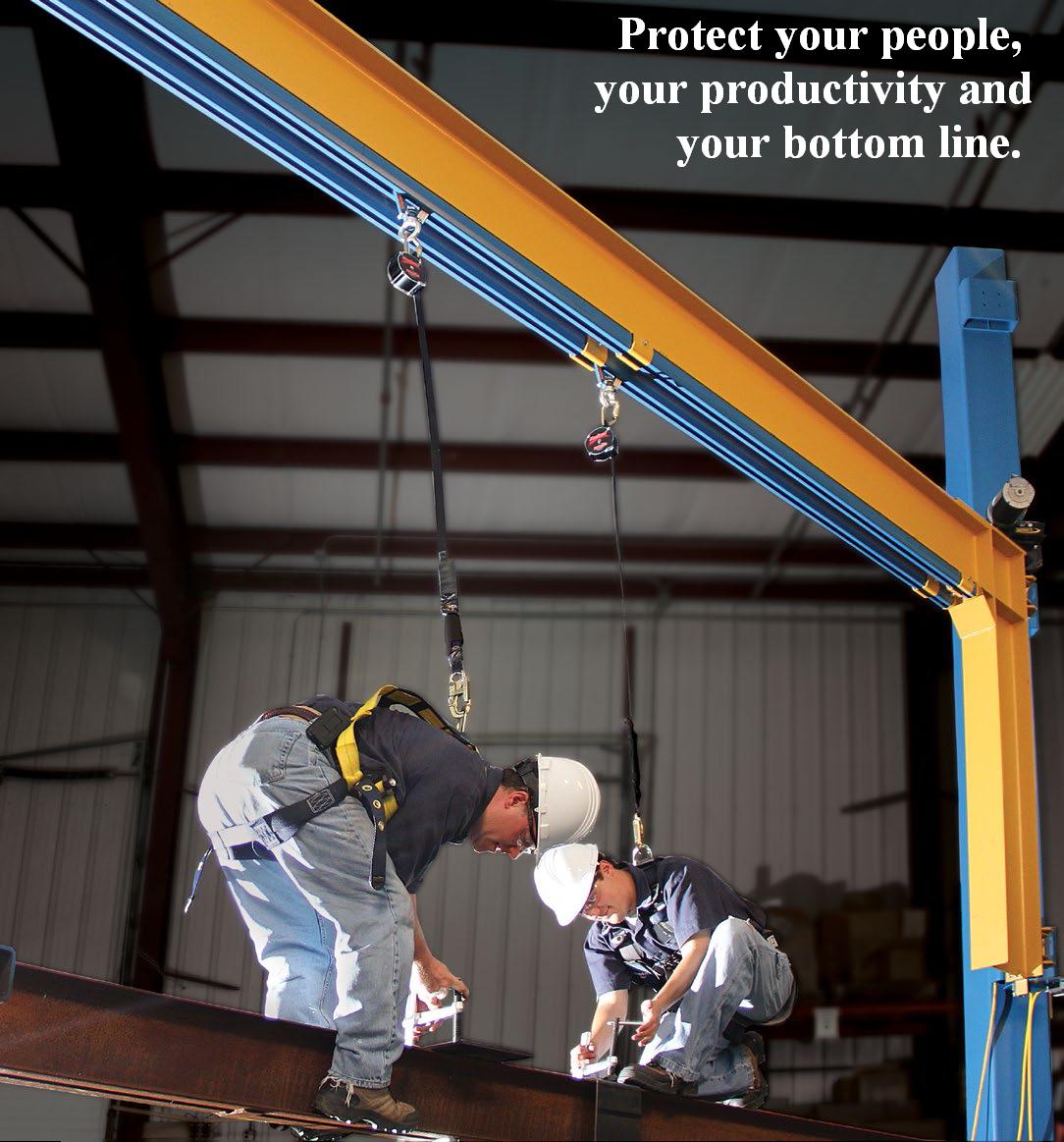
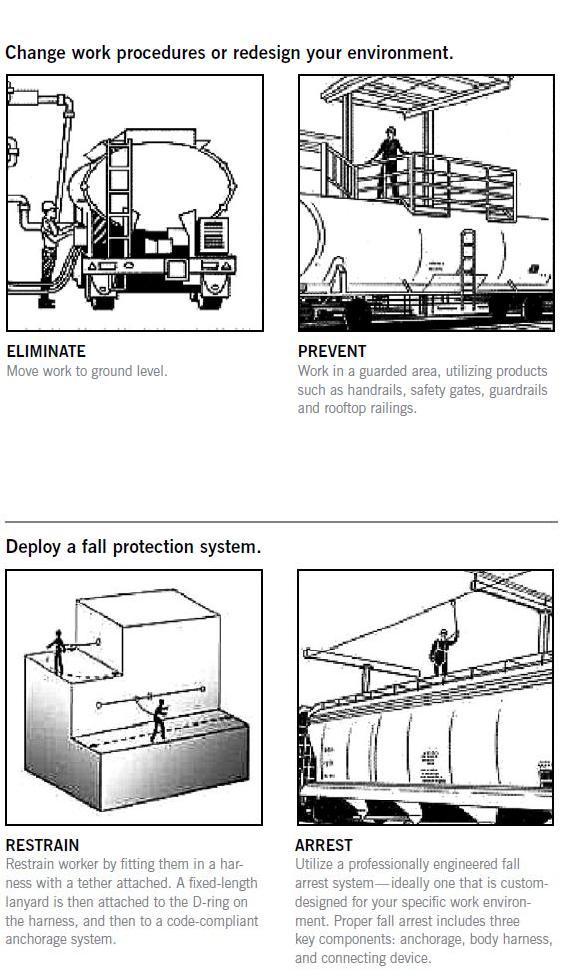
Do You Need Fall Protection?
An all-inclusive fall protection program begins with the ability to identify all fall hazards in your workplace. As a general rule, when someone is working from a height greater than four feet (1.2 m), a fall hazard exists and must be addressed in order to prevent work-related injuries and avoid OSHA fines.
Once a fall hazard has been identified, you typically have two options:
1) Eliminate the hazard altogether, or
2) Provide protection against it.
In some cases, it is possible to eliminate a fall hazard, typically known as “engineering out the hazard,” simply by changing the working environment, processes and procedures. If this is not possible, fall prevention should be the next consideration. Common fall prevention methods include installing guardrails, scaffolds, handrails or barriers. When passive fall protection solutions such as elimination or prevention are not practical, personal fall protection equipment, such as harnesses, lanyards and retractable lifelines can be used.
Personal fall protection may consist of a restraint system to keep the worker from reaching an area where a fall hazard exists, or a personal fall arrest system that enables a worker to perform their duties from the height required, while tied off to the system. If a need for fall protection is determined, the next step is to carefully consider the four options illustrated here.
Components of a Fall Arrest System
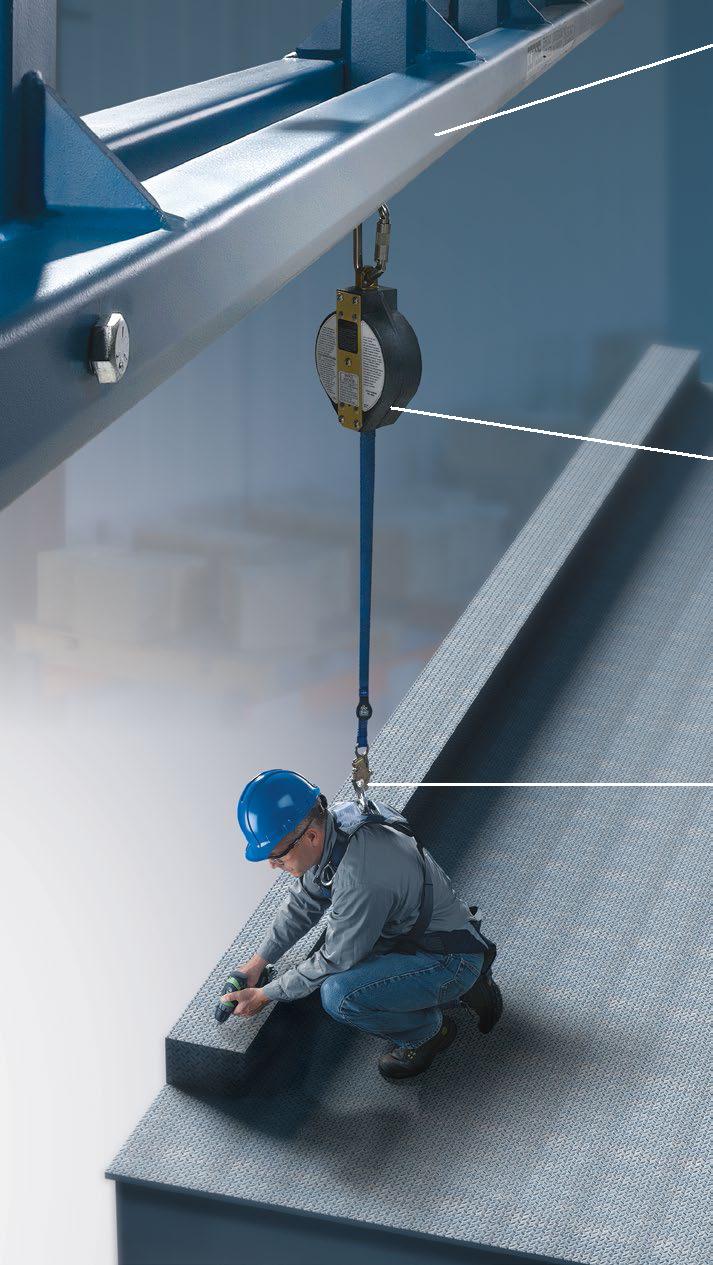
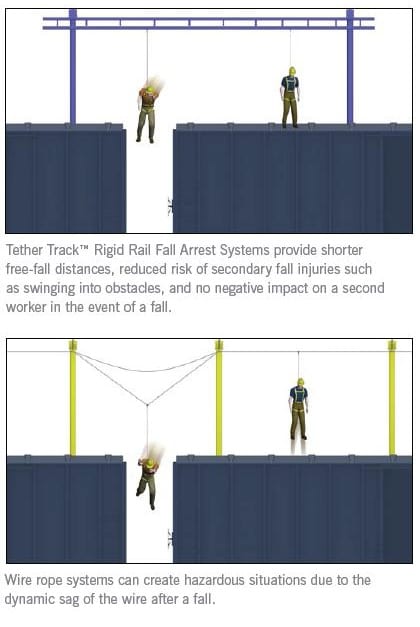
1. ANCHORAGE: A secure point of attachment for lifelines, lanyards or deceleration devices; commonly referred to as a tie-off point. ANSI Z359 further defines anchorage as a fixed structural component such as a beam, girder, column or floor that can support the forces exerted in arresting a fall.
2. CONNECTING DEVICE: A device used to link the body support component of the system to the anchorage connector, such as a shock-absorbing lanyard or self-retracting lanyard (SRL).
3. BODY HARNESS: Provides a connection point on the worker to distribute the forces evenly across the body in the event of a fall. A full body harness is a body support device that distributes fall arrest forces across the shoulders, thighs, and pelvis—and has a center back fall arrest attachment, typically a D-ring, for connection to the fall arrest connecting device.
Fall Arrest Systems, A Class Above Traditional Wire Rope.
LESS FALL CLEARANCE DISTANCE—Wire rope systems require additional fall clearance due to the initial sag of the wire. The dynamic sag, or the stretch of the rope during a fall, adds to this distance. A Tether Track™ Rigid Rail Fall Arrest System stops the fall sooner by eliminating any sag, stopping the fall in a much shorter distance than wire rope.
REDUCED RISK OF SWING FALL INJURIES—Injuries occurring after the fall, such as swinging into obstacles, are minimized with a rigid rail fall arrest system, which stays firm and minimizes the total fall distance. When a worker falls on a wire rope system, the wire’s sag will make the trolley slide to the center of the nearest two supports, creating a risk for the worker to collide with nearby obstacles after a fall.
LONGER DISTANCES BETWEEN SUPPORTS—A rigid rail fall arrest system allows for longer distances between supports, reducing both material and installation costs.
SAFER WORK FOR MULTIPLE WORKERS—When a worker falls on a wire rope system, any slack on the wire is eliminated. The result could be a sudden pull on the rope that could have a jarring effect on other workers on the same system. Rigid rail fall arrest systems provide uninterrupted protection for additional workers on the same system. In the event of one worker’s fall, the rigid rail system will not bend or deflect like a wire rope system, allowing additional workers to continue to move freely and safely.
AFTER A FALL—The worker can continue use of a rigid rail fall arrest system after a visual inspection. A wire rope system must be replaced and re-certified by a qualified engineer.
Benefits of a Rigid Rail Fall Arrest System
While it’s name might imply otherwise, rigid rail systems are the most flexible forms of fall arrest. Ideal for environments where there is limited clearance between the working level and lower level or obstruction, these systems provide a shorter free-fall distance and a reduced risk of secondary injury due to impacts during the free fall or sudden deceleration. Rigid rail fall arrest systems are the perfect solution for permanent applications and can easily be customized to fit every situation.
Getting Your Safety on The Right Track
Gorbel—a leader in overhead material handling—offers one of the most complete lines of rigid rail fall arrest systems available today. Featuring an enclosed track design, exclusively engineered for easy movement, Tether Track™ Systems provide the highest degree of mobility and safety, while reducing the risk of injury in elevated work environments. Designed by qualified engineers, Tether Track™ systems are available in multiple configurations, including various track profiles and support center distances, and meet the OSHA 1926 Subpart M Construction Standard, as well as the ANSI Z359 Fall Protection Code.
The Safest Solution For Virtually Every Environment
Engineered for easy movement, all Tether Track™ systems can be designed to accommodate multiple workers, utilizing dual bypassing track that allows them to maneuver around each other without disconnecting. Choose the configuration that best meets the needs of your environment:
CEILING MOUNTED MONORAIL SYSTEMS –>
• Provide mobility along a single axis for applications when workers need to travel in a straight line
• Curved track sections available
• Variety of hanger options available to accommodate various building structures
• Unlimited monorail lengths with up to 50’* between supports
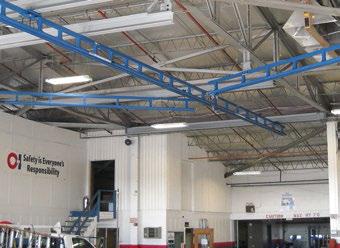
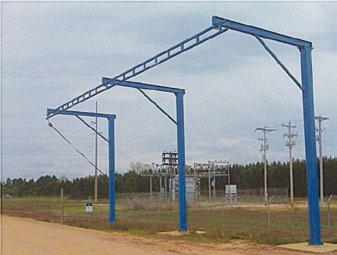
<– FREE STANDING MONORAIL SYSTEMS
• Provide free standing support when building structure is inadequate for ceiling mounted applications
• Available in free standing cantilevered or goal post designs
– Cantilevered design allows for fewer support columns and accommodates headroom constraints
– Goal post design can be bolted directly into concrete floor, reducing the need for costly foundations
• Standard support centers from 7′ to 35′, and up to 50’* custom designed
BRIDGE SYSTEMS –>
• Consist of two runways and a traveling bridge for maximum coverage within a rectangular work area
• Lightweight aluminum bridge follows the worker, remaining directly overhead
• Available in ceiling mounted or free standing designs
• Plain or trussed track runways based on support center requirement
• Multiple bridges can accommodate several workers when properly zoned
• Unlimited runway lengths, with up to 30′ bridge spans
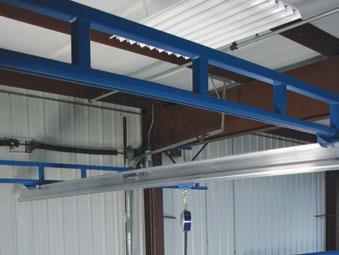
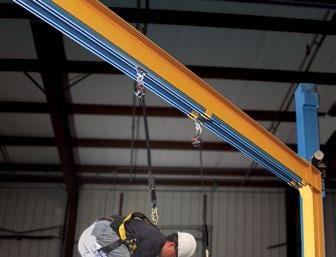
<– SWING ARM SYSTEMS
• Provide circular or semicircular fall protection with a compact footprint
• Versatile and adaptable; swing arm can be moved out of the way when not in use
• Wall mounted, column mounted or free standing designs
• Available in wall cantilever or wall bracket configurations, depending on headroom constraints
• Infinitely variable friction brake or motorized rotation available
• Standard arm lengths from 8′ to 30′, custom spans available upon request
FOLD AWAY SYSTEMS –>
• Deploy as needed, then fold away when done
• Perfect for work cells requiring access to overhead cranes, when floor space is limited or when infrequent fall protection is necessary
• Wall mounted, column mounted or free standing designs
• Available in wall cantilever or wall bracket configurations, depending on headroom constraints
• Infinitely variable friction brake or motorized rotation available
• Unlimited lengths with up to 50′ between supports
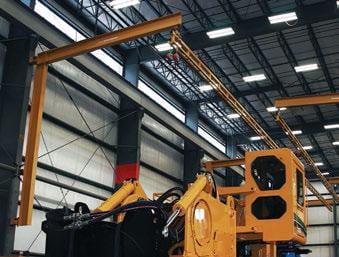
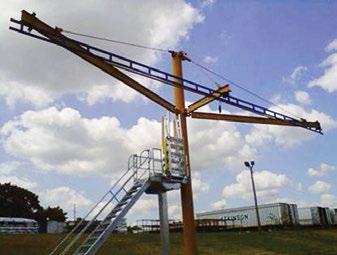
<– SINGLE POLE SYSTEMS
• Space-saving design allows for installation in areas where there
is minimal floor space or limited room for foundations
• Utilizes only one free standing support with one single foundation
• Standard track lengths up to 53′

